© Photo de l'artiste Tommy-May-by-Charles-Freger-(Gorman-Collab), with the courtesy of Mangkaja Art
Avant de traverser le monde, ils vivaient dans les déserts les plus éloignés d’Australie. Aujourd’hui, ils sont artistes et exposent de l’Europe à New-York. A eux seuls ils résument une accélération du temps impressionnante à l’échelle d’une vie et toute l’importance de la préservation du savoir.
Voici l’histoire de Ngarralja Tommy May, né en 1935 à Yarrnkurnja dans le Great Sandy Désert, actuellement exposé à Bruxelles.
"J'étais grand quand j'ai quitté mon pays. Je chassais déjà tout seul. J'étais avec mon jeune frère et ma mère. Mon père était décédé à ce moment-là. Je connais les histoires et les endroits clefs dans mon pays. Cependant nous ne sommes pas autorisés à les peindre pour le pays des autres. Nous serions tués ou nous aurions des problèmes si nous faisions cela.
Il y a des histoires plus au moins faciles, loin d’être aussi sensibles que le law business, mais nous ne pouvons pas les peindre non plus".
"J'ai d'abord vu des peintures dans des grottes. J'ai beaucoup appris des anciens, surtout de mon père et de mon grand-père. Je vivais dans tous les endroits de mon pays, où nous campions. Wurna juwal, toujours en mouvement".
Ngarralja Tommy May danse et chante le lieu fondamental de Kurtal, où se déroule une cérémonie importante relative au jila [trou d'eau vivant] principal dans son pays. Il est également un des derniers rain makers (faiseur de pluie du désert) d’Australie.
"Quand je peins, je ne cesse d’y penser. Mon travail consiste maintenant en des dessins pour la gravure, directement sur l’étain, ou parfois sur le bois, à l'aide d'un couteau ou d'un stylo. Je travaille tous les jours et j’ai beaucoup voyagé avec mes peintures. A Singapour, Houston, Washington D.C., New York" tout récemment pour la Outsider Art Fair début 2020.
Son histoire personnelle est un mélange complexe de ses expériences vécues, du Temps du Rêve, de ses liens profonds avec les lieux et des bouleversements avec l’installation des stations d’élevage immenses dans le Kimberley par les occidentaux. Elles ont amené de nombreux hommes du désert et leur famille à effectué un travail forcé dans les fermes éloignées.
Le langage visuel complexe de Tommy traite et conjugue ces multiples dimensions, pour partager, protester et nous interpeller sur ces histoires non documentées de son peuple.
Peinture Aborigène de l’artiste Ngarralja Tommy May, Kurtal_Tommy - 120 x 120 cm - 435/18 © Photo Aboriginal Signature Estrangin Gallery with the courtesy of the artist.
Ngarralja Tommy May parle couramment le Wangkajunga, le Walmajarri et l'anglais et écrit le Walmajarri, langues rares dont il existe juste 850 locuteurs aujourd’hui. C'est un membre fondateur du centre d'éducation des adultes de Karrayili où il a appris à lire et à écrire sa propre langue et l’anglais.
Ngarralja est une personne importante pour l'art et la culture à Fitzroy Crossing. Il est un ancien député Président de Mangkaja Arts et ancien président du Kimberley Aboriginal Law and Cultural Centre(KALACC).
Ngarralja a également été cadre pendant 21 ans au sein de l'Association of Northern Kimberley and Arnhem Aboriginal Artists (ANKAAA) Board of Directors.
Il est un des derniers artistes vivants, ayant contribué à la toile magistrale de 10 m x 8m, « Ngurarra » utilisée pour revendiquer avec succès leurs terres indigènes, sur un vaste territoires de 100 000 km2. Aujourd’hui Ngarralja vit avec ses enfants dans la communauté Mindi Rardi à Fitzroy Crossing et continue de transmettre son savoir et de créer des œuvres à 86 ans.
Peinture Aborigène de l’artiste Ngarralja Tommy May, Kurtal_Tommy - 60 x 60 cm - 242/19 © Photo Aboriginal Signature Estrangin Gallery with the courtesy of the artist.
Vous pouvez retrouver ses œuvres dans les prestigieux musées et collections suivantes :
Kluge Ruhe Museum of Aboriginal Art – Charlottesville USA
National Museum of Australia, Canberra
National Gallery of Victoria
Curtin University Collection, Perth
Queensland State Art Gallery Berndt
Museum of Anthropology Australian Print Workshop
Flinders University Art Museum, Adelaide
Carleton College Art Collection, Northfield Minnesota
Kennesaw State University Little













